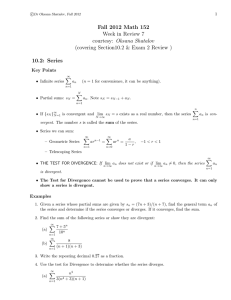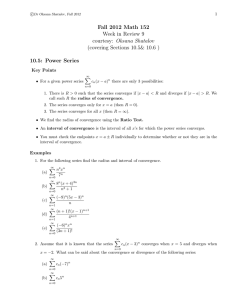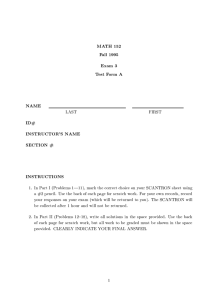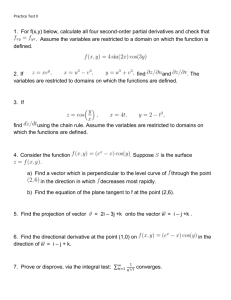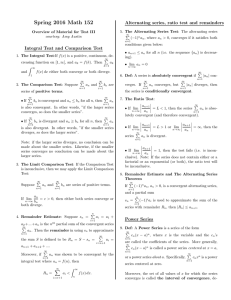Document 10503087
advertisement
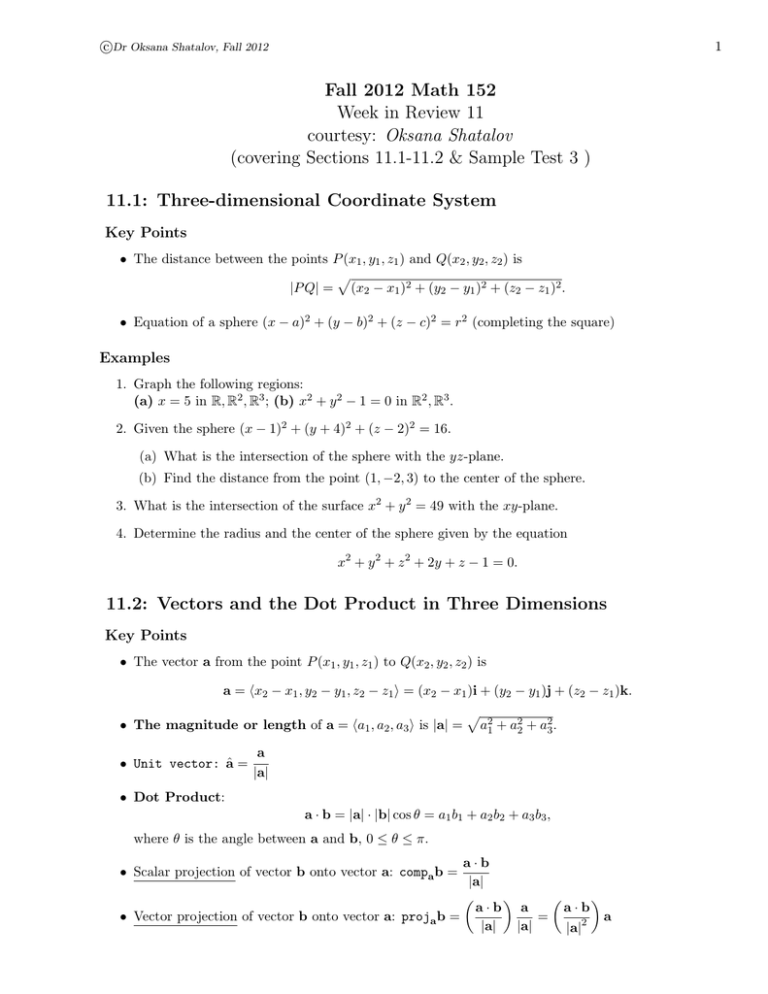
c Dr Oksana Shatalov, Fall 2012 1 Fall 2012 Math 152 Week in Review 11 courtesy: Oksana Shatalov (covering Sections 11.1-11.2 & Sample Test 3 ) 11.1: Three-dimensional Coordinate System Key Points • The distance between the points P (x1 , y1 , z1 ) and Q(x2 , y2 , z2 ) is p |P Q| = (x2 − x1 )2 + (y2 − y1 )2 + (z2 − z1 )2 . • Equation of a sphere (x − a)2 + (y − b)2 + (z − c)2 = r2 (completing the square) Examples 1. Graph the following regions: (a) x = 5 in R, R2 , R3 ; (b) x2 + y 2 − 1 = 0 in R2 , R3 . 2. Given the sphere (x − 1)2 + (y + 4)2 + (z − 2)2 = 16. (a) What is the intersection of the sphere with the yz-plane. (b) Find the distance from the point (1, −2, 3) to the center of the sphere. 3. What is the intersection of the surface x2 + y 2 = 49 with the xy-plane. 4. Determine the radius and the center of the sphere given by the equation x2 + y 2 + z 2 + 2y + z − 1 = 0. 11.2: Vectors and the Dot Product in Three Dimensions Key Points • The vector a from the point P (x1 , y1 , z1 ) to Q(x2 , y2 , z2 ) is a = hx2 − x1 , y2 − y1 , z2 − z1 i = (x2 − x1 )i + (y2 − y1 )j + (z2 − z1 )k. • The magnitude or length of a = ha1 , a2 , a3 i is |a| = • Unit vector: â = p a21 + a22 + a23 . a |a| • Dot Product: a · b = |a| · |b| cos θ = a1 b1 + a2 b2 + a3 b3 , where θ is the angle between a and b, 0 ≤ θ ≤ π. a·b |a| a·b a a·b • Vector projection of vector b onto vector a: proja b = = a |a| |a| |a|2 • Scalar projection of vector b onto vector a: compa b = c Dr Oksana Shatalov, Fall 2012 2 Examples 5. Given the triangle with vertices A(2, 4, 5), B(3, 5, 3), and C(2, 8, −3). (a) Find the cosine of the angle at B. ~ (b) Compute comp ~ BC. AB ~ (c) Compute projAB ~ BC. 6. Find a unit vector in the direction b − a where a = h3, −7, 0i and b = h1, −6, −2i. 7. The line L1 passes througn the points M (3, 5, 3) and N (2, 8, −3), and the line L2 passes througn the points P (−1, −1, 1) and Q(12, 0, −1). Are these lines orthogonal? Sample Test 3 8. Which of the following series converges absolutely? (a) (b) ∞ X (−1)n+5 n=1 ∞ X sin (π 3 n2 ) √ 2 n n n=1 ∞ X (−1)n √ (c) 4 n n=1 (d) (e) (f) ∞ X (−1)n n=1 ∞ X n=1 ∞ X n=1 ln n nn (n!)2 5n ln(n + 1) 9. Suppose that the power series ∞ X cn (x − 4)n has the radius of convergence 4. Consider the following n=1 pair of series: (I) ∞ X cn 5 n (II) n=1 ∞ X cn 3n . n=1 Which of the following statements is true? (a) (I) is convergent, (II)is divergent (b) Neither series is convergent (c) Bith series are convergent (d) (I) is divergent, (II) is convergent (e) no conclusion can be drawn about either series. 10. Show that the series ∞ X ln n converges. Then find un upper bound on the error in using s10 to n2 approximate the series. (Note that ln 2 > 1/2.) n=2 c Dr Oksana Shatalov, Fall 2012 3 x2 as a power series centered at a = 0, what is the associated radius of 4 + 9x2 11. If we represent convergence? 12. Find the radius and interval of convergence of the series ∞ X (−2)n (3x − 1)n n n=1 . 13. Which of the following statements is TRUE? ∞ X (a) If an > 0 for n ≥ 1 and (b) If an > 0 for n ≥ 1 and (c) If lim an = 0 then n→∞ ∞ X (−1)n an converges then n=1 ∞ X ∞ X n=1 n=1 ∞ X an converges. n=1 an converges then (−1)n an converges. (−1)n an converges. n=1 ∞ X e an+1 = then an converges. n→∞ an 2 (d) If an > 0 for n ≥ 1 and lim n=1 14. Find a Maclaurin series representation for ex − 1 − x . x2 15. (a) Find a Maclaurin series representation for f (x) = sin 1 x2 4 x2 dx as an infinite series. 4 0 (c) Using the series found in the previous part, find s2 , the second partial sum of the series and give an upper bound on the error |s − s2 |. Z (b) Write sin 16. Let f (x) = e5−x . (a) Give the fourth degree Taylor polynomial for f (x) centered around a = 5. (b) Use Taylor’s inequality to give a bound on the error when using the fourth degree Taylor polynomial for f (x) to estimate f (x) on the interval [3, 6]. 17. Find a Maclaurin series of f (x) = ln(2 − x) and the associated radius of convergence. 18. The series ∞ X (−1)n+1 n=1 n2 3n converges to s. Use the Alternating Series Theorem to estimate |s − s6 |.

